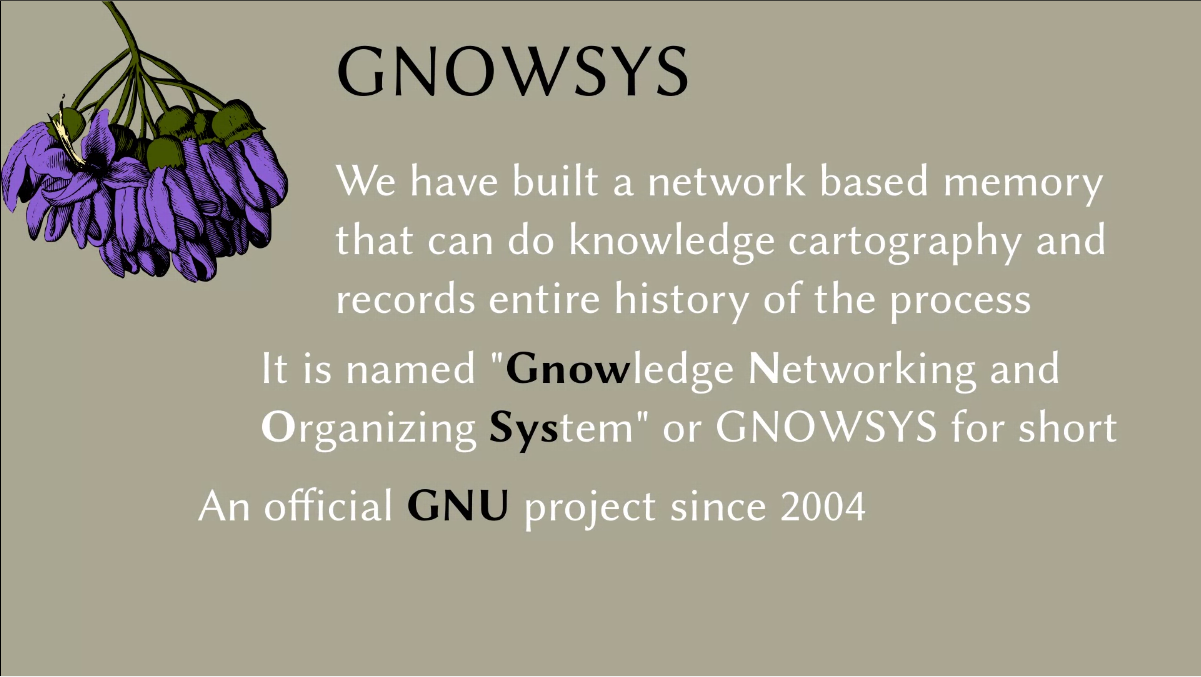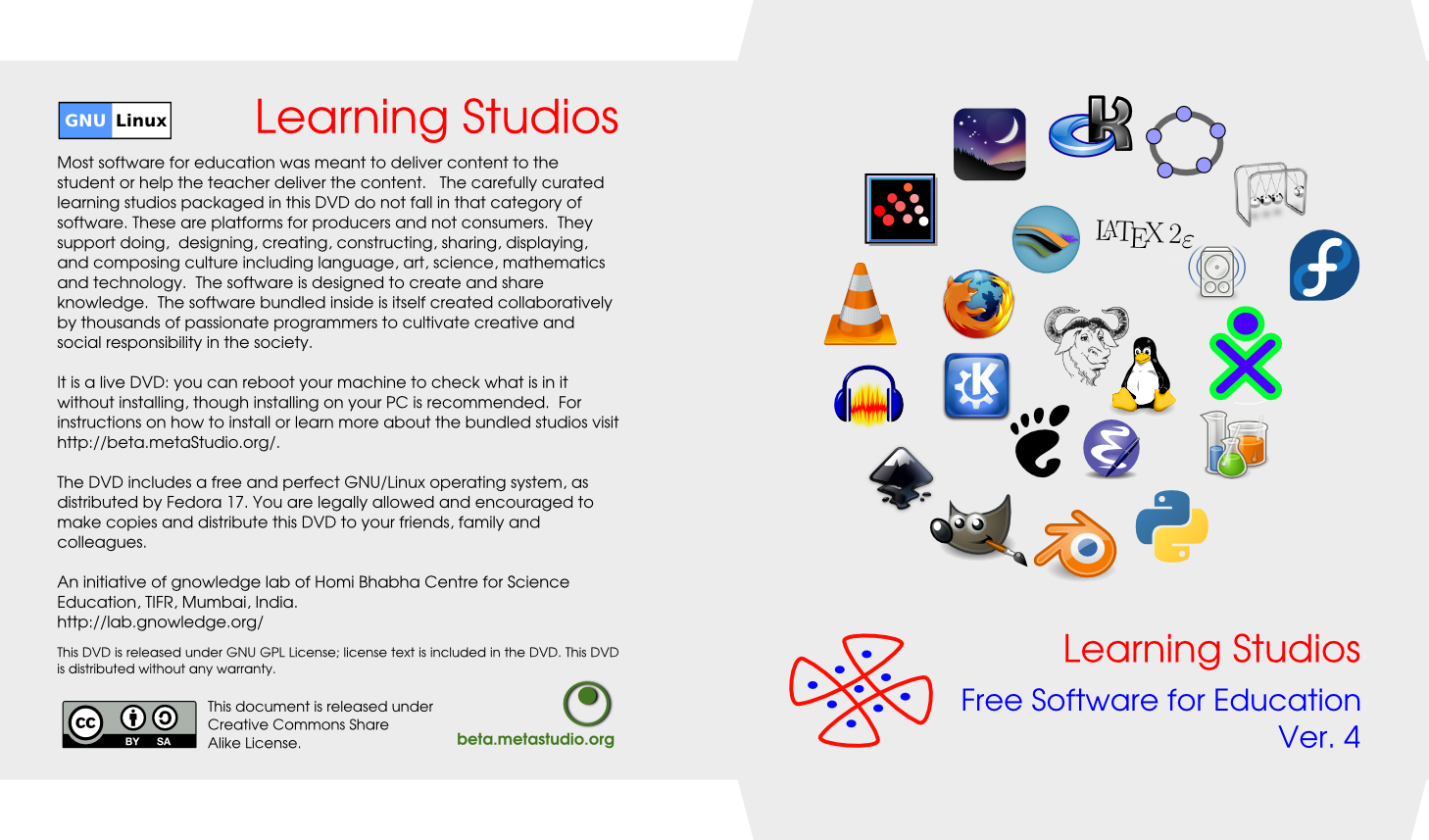GNOWSYS and Gstudio

Introduction to GNOWSYS
GNOWSYS is a specification for a generic distributed network based memory/knowledge management. Typically computer memory is managed as a tree, or as nested arrays. Our attempt in this project is to represent all forms of declarative and procedural knowledge as a network, and then develop network processing methods to create and publish knowledge as a network.

Node orientated computing
Just as the language LISP provides list oriented computing framework, we try to model the knowledge as nodes in a network. The interpretation (meaning) of a node depends on the links the node has with other nodes, and the interpretation of the other neighbouring nodes in turn depends on their network and so on. The nodes are organized and processed according to a complex data structure called the neighborhood, akin to a frame.
Read more details of the project GNOWSYS
DOER: Disk of OER
DOER (Distributed Decentralized DISK of Open Online Ongoing Engagement Repository): Our innovations in technology often involve integrating existing technologies for addressing the needs of remote locations. We provide fast Internet as well as a bleeding-edge data center in places where ISPs do not reach. This data center that is delivered as an inter-operable DISK which provides access to sophisticated communication and social networking platform for remote areas. Other similar projects done elsewhere in the world, e.g. Internet-in-a-Box focus on delivering content. While, we focus on the remote communities as producers and not merely consumers of content created elsewhere. Therefore, we package multiple servers that provide Communication and Production Studio that works off the grid in any operating system on a single regular desktop machine using cutting-edge container technology using commodity-ware wireless (radios).
This disk provides fast internet experience along with collaborative workspaces with a ledger, analytics, transmitting and syncing mechanisms to visualize their activities, peer to peer feedback to generate qualitative and quantitative index of their performance. These inter-operable disks are currently being piloted and sent to remote schools in four states in India through the CLIx project in collaboration with Tata Trusts, TISS and NCERT and we are receiving encouraging stories and feedback from them. What we are shipping currently are showcased here: http://nroer.gov.in/, https://clixplatform.tiss.edu and http://doer.metastudio.org/
Read more details about what DOER DISK contains.
Learning Studios: A customized operating system for STEM Education

Most mainstream software for education was meant to deliver content to the student or help the teacher deliver the content. The carefully curated learning studios packaged by the lab into a DVD do not fall in that category of software. These are platforms for producers and not consumers, consistent with the constructionist philosophy adopted by the lab. They support doing, designing, creating, constructing, sharing, displaying, and composing culture including language, art, science, mathematics and technology. The software bundled inside is itself created collaboratively by thousands of passionate geeks to cultivate creativity and social responsibility in society. The DVD contains carefully curated applications starting from primary school to graduate level. The DVD is being distributed to students and teachers across the country. The lab conducted more than 25 hands-on workshops based on the DVD across the country. The applications are customized as a part of a free and open source GNU/Linux operating system. NCERT has adopted the DVD for nationwide distribution and developing the ICT courses for schools across the country. The Learning Studios DVD eventually included the sugar learning platform which runs on the One Laptop Per Child (OLPC).

MOOC on Digital Literacy
Nagarjuna G., Amit Dhakulkar, Chandita Mukherjee,
Arun Ganesh, Haimanti Pakrashi
The Digital Literacy course intends to empower the learners to use digital resources effectively and collaboratively. Digital Literacy is a core course of the NUSSD (National Unviersity Students Skill Devleopment) project coordinated by TISS (Tata Institute of Fundamental Research). The skills acquired during this course will be lifelong in nature. In Digital Literacy course the approach is collaborative and project based. In this framework, a series of challenges will be placed before students which they will have to work through by doing and discovering. The assessment of the students will be based on the quality of results they produce and the self-learning that they demonstrate. Both peer-to-peer and mentor assessment will be employed in the evaluation of the students. Implemented in this way the Digital Literacy course borrows the central ideas of open online, collaborative, peer-2-peer model of learning using connectionist and constructionist methods.
The Digital Literacy course is planned with certain design principles in mind. These design principles have construction, collaboration and the community as central strands around which the course structure is woven. Since the course itself will be implemented with National Service Scheme (NSS) volunteers, we found it imperative that the guiding principles of NSS should also find reflection in the course structure. The objectives of the NSS programme are strongly connected to the community around the participating students. In case of Digital Literacy also the community plays a central role in the projects done by the participating learners.
This course is delivered to more than 20,000 students across India by the NUSSD program, and the course is still being offered. An online archived version of thhe MOOC course is available from here.
Download the PDF document describing the Course
An Invitation to Connected Learning Initiative (CLIx)
I2C is designed to be an easy and exemplary connected learning experience, facilitated through a specially designed course platform - a social space where collaborative interactions happen. i2C aims to prepare learners for conceptual and investigative engagements in Science, Mathematics and English Communication as offered through CLIx.
More details about initiative can be found here
naYana
The naYana phonetic alphabet is created by Nagarjuna G. and Vickram Crishna and few other collaborators and interns at the gnowledge lab (https://www.gnowledge.org) of Homi Bhabha Centre for Science Education (https://www.hbcse.tifr.res.in), Tata Institute of Fundamental Research (TIFR) at Mumbai in India (See full credits below). The current version is a result of iterative development that started around 2012. The protoype OTF font for the alphabet with latin keyboard mapping is designed and developed by Nagarjuna G.Download the OTF font.
More details about the project can be found here